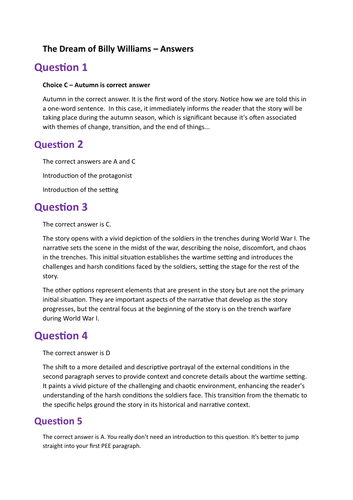






This quiz is based on a very short story of just 458 words called “The Dream of Billy Williams”. It is followed by 19 multiple choice questions and 3 order questions. For those who finish early there is an extension task at the end. This resource was originally created as there don’t seem to be many “structure” resources out there that are good quality and teach the learners anything except the terminology! I believe this quiz provoked some thought about how to respond to the question in an exam scenario.
This is ideal for a cover lesson, too, as it produces no marking, as long as the answers are given out once the quiz is complete (learners can mark their own or can exchange their papers with others).
I would advise reading the story out loud at the start to ensure that all the learners have read it and do not (as is sometimes the case) attempt the “pot luck”” strategy of answering the question.
The story is set during the First World War and focuses on a soldier, Billy Williams who can sleep through anything - but unfortunately this does not ultimately save him. The description of his death is not “blood and guts” but focuses on his obliteration by a shell. The story uses all the skills to get a very high grade for Paper 1 Question 5. As such, it can also be used as an exemplar for that question, too.
There is also a comprehensive answer booklet with explanations so that the teacher who is doing the lesson can respond to learner questions about why the right answer was… the right answer!
The order questions are a student responses (done in the PEE manner). Learners have to put them in the right order. The point and evidence are presented in the first sentence. The two explanatory sentences can be separated in terms of order because the final point has a linking word or phrase indicating summation is in process.
Although this quiz is “low stakes” in nature, it covers a large amount of subject terminology which can be discussed at the time when the answers are given. The aim is to embed this terminology as well as exposing students to ways in which it could be incorporated into their own attempts at P1Q3.
The text is also provided separately as there are always learners who ask for this so they do not have to keep flicking back and forth.
PDF and Word formats for the documents are included.
This quiz would easily be adaptable into an online version if you wanted to do the quiz as homework, The questions and answers could be quickly copied and pasted into MS Forms or a Moodle interface – and the explanations given in the answer booklet could also be used to enable online automated feedback.
Enjoy!
Something went wrong, please try again later.
This resource hasn't been reviewed yet
To ensure quality for our reviews, only customers who have purchased this resource can review it
Report this resourceto let us know if it violates our terms and conditions.
Our customer service team will review your report and will be in touch.